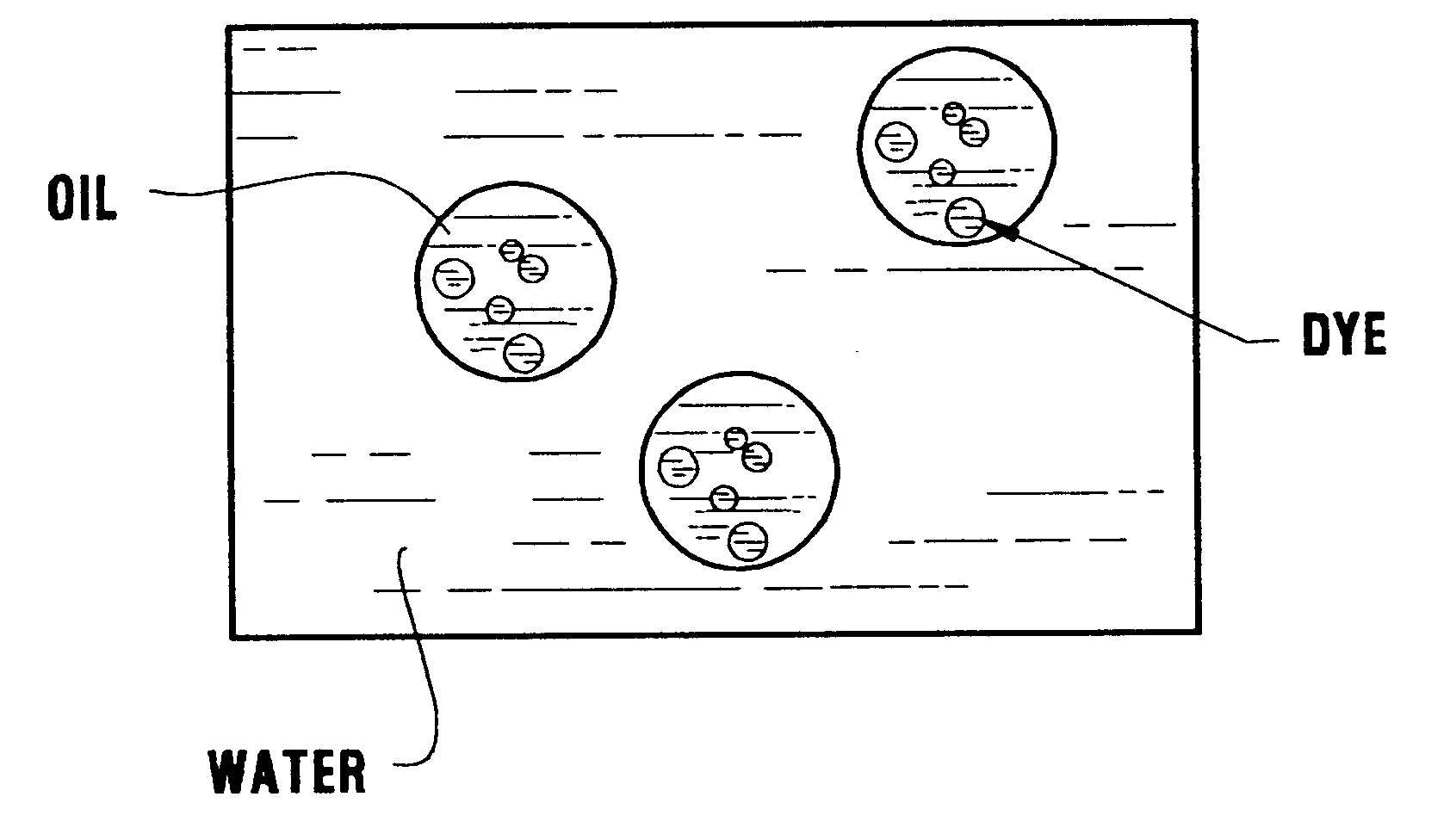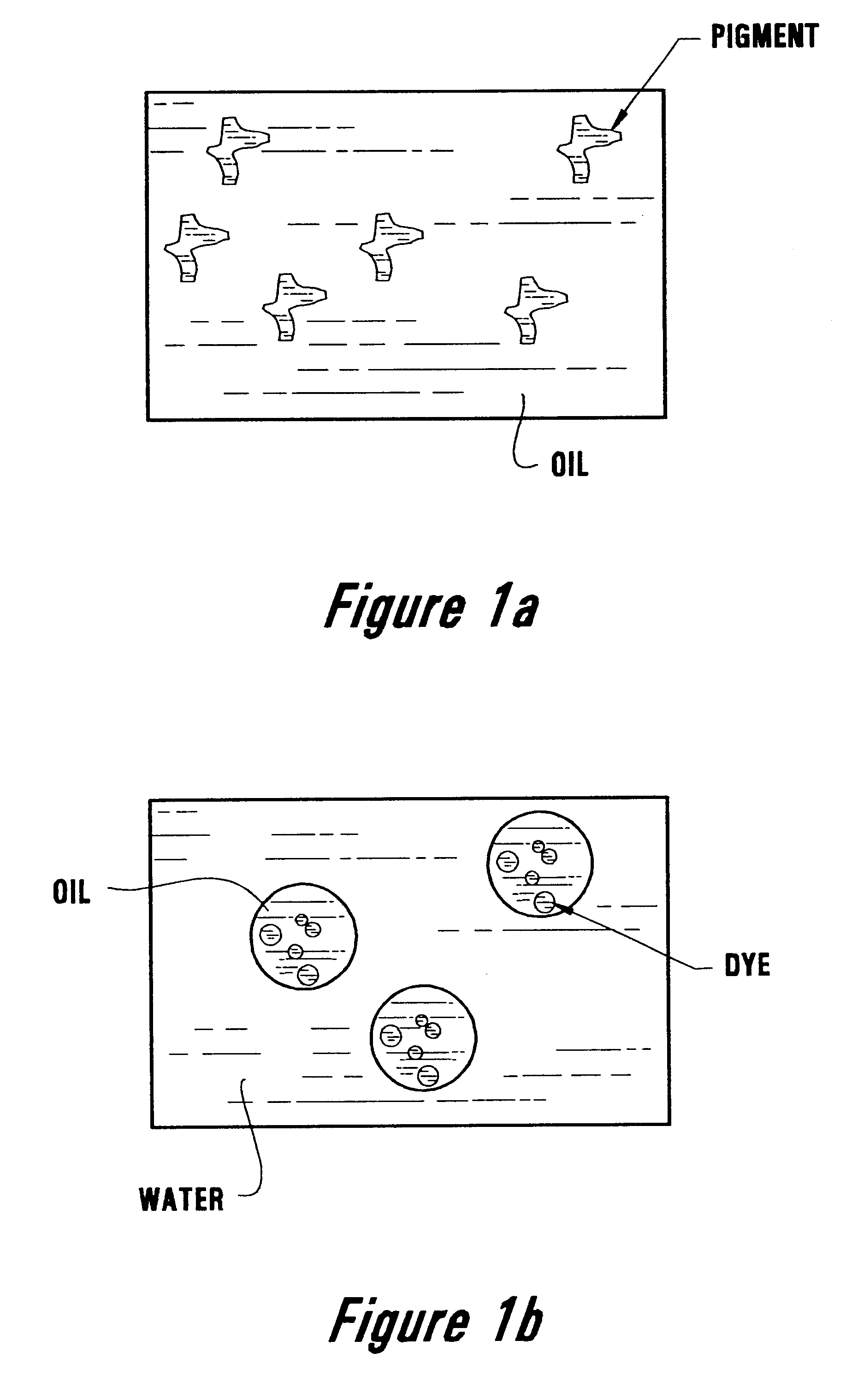Miniemulsion techniques for ink jet inks
a technology of ink jet and ink jet, which is applied in the direction of inks, duplicating/marking methods, printing, etc., can solve the problems of poor bleed, inferior optical density/chroma, feathering,
- Summary
- Abstract
- Description
- Claims
- Application Information
AI Technical Summary
Problems solved by technology
Method used
Image
Examples
example 1
Cyan, magenta and yellow miniemulsion inks were prepared with the ingredients listed in the following Table 1a. The dyes were dissolved in the soybean oil to saturation. The other components were mixed together in water. The oil was added to the aqueous solution, pre-mixed with a T25 Ultratorrax (Kunkel, IKA Laboratechnik) and sonicated for 10 minutes in an ice bath (XL Sonicator (Neat Systems)).
Tests were conducted on different media with inks using Solvent Blue 35 (C.I. Index Solvent Blue 35) (Cyan); Oil Yellow 2635 (C.I. Index Solvent Yellow 56) (Yellow); and Neozapon Red 395 (C.I. Index Solvent Red 122) (Magenta). Results are shown in Table 2 below. The inks showed a good printability (no nozzles out) and no-excuse waterfastness, highlighter smear fastness, and wet finger smudge on a variety of media, including offset glossy media. The printing was conducted with or without underprinting by a cationic fixer 100% v / v.
The fixer had the composition given in Table 1b below:
The ink-t...
example 2
The following dye solutions were prepared:
Cyan: Savinyl Blue GLS (C.I. Index Solvent Blue 44) (Clariant), 30 wt %; 1-Dodecyl-2-pyrrolidone (Aldrich) 60 wt %; dodecane (Aldrich), 10 wt %.
Black: Savinyl Black NS (Proprietary)(Clariant), 30 wt %; 1-Dodecyl-2-pyrrolidone (Aldrich), 60 wt %; dodecane (Aldrich), 10 wt %.
Yellow #1: Savinyl Yellow RLS (C.I. Index Solvent Yellow 83:1) (Clariant), 30 wt %; 1-Dodecyl-2-pyrrolidone (Aldrich), 60 Wt %; dodecane (Aldrich), 10 wt %.
Yellow #2: (comparative example): Savinyl Yellow RLS (C.I. Index Solvent Yellow 83:1) (Clariant), 30 wt %; 1-Dodecyl-2-pyrrolidone (Aldrich), 70 wt %.
The following aqueous ink vehicle was prepared with the components given in Table 2:
Then 1.5 g of each dye solution described above was emulsified in 13.5 g of the ink vehicle using an XL Sonicator (Heat Systems). The samples were sonicated for 5 minutes in a pulse mode (1 s+1 s) on an ice bath at 1 / 2 of maximum power. After sonication, the inks were filtered through a 1.2...
example 3
Particle Size Data of Emulsions
The average particle size data of emulsions prepared according to Example 2 were measured using a Nicomp particle size analyzer (Particle Sizing Systems, Inc., Santa Barbara, Calif., USA) at 90.degree. scattering angle and .about.1:10000 dilution. The data are shown in the table below.
Just 3 days after preparation, the difference between the two yellow inks becomes apparent. While the average particle size of the dodecane-containing miniemulsion did not change, the control emulsion shows a considerable particle size increase.
PUM
| Property | Measurement | Unit |
|---|---|---|
| Percent by mass | aaaaa | aaaaa |
| Percent by mass | aaaaa | aaaaa |
| Percent by mass | aaaaa | aaaaa |
Abstract
Description
Claims
Application Information
 Login to View More
Login to View More - R&D
- Intellectual Property
- Life Sciences
- Materials
- Tech Scout
- Unparalleled Data Quality
- Higher Quality Content
- 60% Fewer Hallucinations
Browse by: Latest US Patents, China's latest patents, Technical Efficacy Thesaurus, Application Domain, Technology Topic, Popular Technical Reports.
© 2025 PatSnap. All rights reserved.Legal|Privacy policy|Modern Slavery Act Transparency Statement|Sitemap|About US| Contact US: help@patsnap.com


